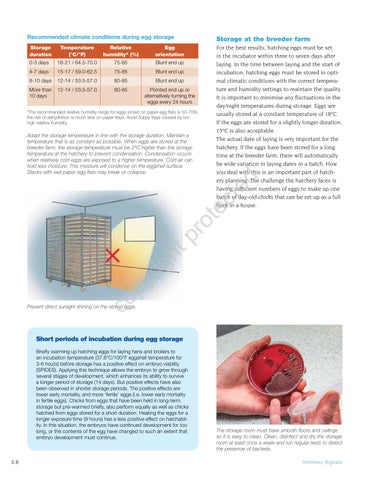Recommended climate conditions during egg storage Storage duration
Temperature (°C/°F)
Relative humidity* (%)
Egg orientation
0-3 days
18-21 / 64.5-70.0
75-85
Blunt end up
4-7 days
15-17 / 59.0-62.5
75-85
Blunt end up
8-10 days
12-14 / 53.5-57.0
80-85
Blunt end up
More than 10 days
12-14 / 53.5-57.0
80-85
Pointed end up or alternatively turning the eggs every 24 hours
Storage at the breeder farm
*The recommended relative humidity range for eggs stored on paper egg flats is 50-75%; the risk of dehydration is much less on paper trays. Avoid floppy trays caused by too high relative humidity.
co
py
rig
ht
pr ot
ec
te
d
Adapt the storage temperature in line with the storage duration. Maintain a temperature that is as constant as possible. When eggs are stored at the breeder farm, the storage temperature must be 2°C higher than the storage temperature at the hatchery to prevent condensation. Condensation occurs when relatively cold eggs are exposed to a higher temperature. Cold air can hold less moisture. This moisture will condense on the eggshell surface. Stacks with wet paper egg flats may break or collapse.
For the best results, hatching eggs must be set in the incubator within three to seven days after laying. In the time between laying and the start of incubation, hatching eggs must be stored in optimal climatic conditions with the correct temperature and humidity settings to maintain the quality. It is important to minimise any fluctuations in the day/night temperatures during storage. Eggs are usually stored at a constant temperature of 18°C. If the eggs are stored for a slightly longer duration, 15°C is also acceptable. The actual date of laying is very important for the hatchery. If the eggs have been stored for a long time at the breeder farm, there will automatically be wide variation in laying dates in a batch. How you deal with this is an important part of hatchery planning. The challenge the hatchery faces is having sufficient numbers of eggs to make up one batch of day-old chicks that can be set up as a full flock in a house.
Prevent direct sunlight shining on the stored eggs.
Short periods of incubation during egg storage Briefly warming up hatching eggs for laying hens and broilers to an incubation temperature (37.8°C/100°F eggshell temperature for 3-6 hours) before storage has a positive effect on embryo viability (SPIDES). Applying this technique allows the embryo to grow through several stages of development, which enhances its ability to survive a longer period of storage (14 days). But positive effects have also been observed in shorter storage periods. The positive effects are lower early mortality, and more ‘fertile’ eggs (i.e. lower early mortality in fertile eggs). Chicks from eggs that have been held in long-term storage but pre-warmed briefly, also perform equally as well as chicks hatched from eggs stored for a short duration. Heating the eggs for a longer exposure time (9 hours) has a less positive effect on hatchability. In this situation, the embryos have continued development for too long, or the contents of the egg have changed to such an extent that embryo development must continue.
58
The storage room must have smooth floors and ceilings so it is easy to clean. Clean, disinfect and dry the storage room at least once a week and run regular tests to detect the presence of bacteria. Ha tc he ry S i gnal s








































































































